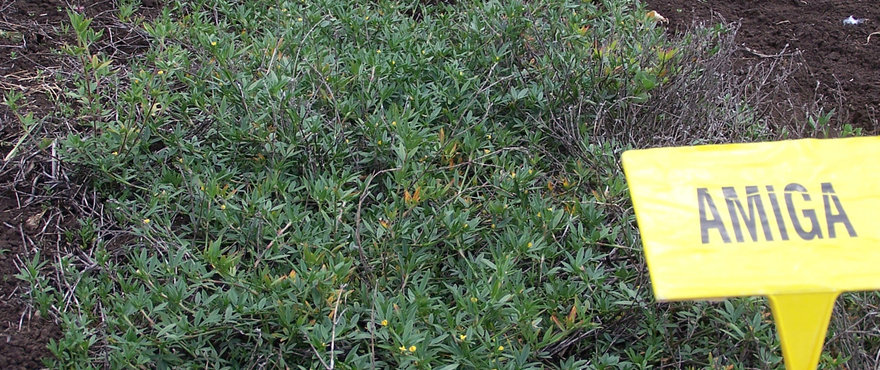Download a copy of the Amiga Stylo factsheet.
A remarkably persistant pasture legume. Amiga has an extra set of chromosomes which translates into a more robust performance. Amiga has a high resistance to the fungal anthracnose disease. Amiga stylo is mostly used for permanent pastures. Good for cut and carry as green feed, or for hay if cut before dry season leaf fall when plants become increasingly stemmy. Can also be used as a ley in cropping systems with nitrogen benefits up to 90 kg/ha recorded in West Africa and northern Australia under experimental conditions. It is used for feeding cattle, goats, sheep, pigs and poultry. Growing use of Amiga stylo in silvipasture systems in India where it is used in undersowing Eucalytus and Dalbergia forests as well as a component in watershed and soil conservation programs.
Key features
- Highly palatable and persistent Verano type stylo
- Produces an abundance of seed
Key benefits
- Suited to cooler more arid regions of the tropics
- Easy to establish
Agronomy and management
Amiga stylo is tolerant of heavy grazing. Stocking rate should be adjusted to reduce competition from associated grass especially early in the growing season, although prolonged heavy grazing can reduce the density of the grass. Grazed Amiga plants tend to perennate better than ungrazed plants. Higher yields can be obtained from commencing grazing at early flowering and then at 4 week intervals, over starting later and grazing less frequently. Can become dominant at the expense of perennial grasses through heavy grazing. Grass and stylo mixtures can be maintained by strategic fire and grazing management with appropriate phosphorus fertiliser use on infertile acid tropical soils.
Establishment
Best sown at the end of the dry season or early in the wet season to allow plants to develop sufficiently before the next dry season or the onset of frost. Amiga can be sown conventionally into the soil, or by air. In tropical Northern parts of Australia, Amiga stylo is also commonly included in “loose lick” fed during the dry season, and readily establishes in the dung.
Pest / disease resistance
There are no major insect pests affecting Amiga. Botrytis head blight is particularly serious in seed crops during periods of high rainfall as it causes death of the flower head. Web blight can damage vegetative growth during wet weather. Anthracnose, which attacks other stylos, is not a problem at this stage.
Performance
Under ideal conditions, can yield up to 17t/ha DM in pure stands, but in mixed pasture, more commonly between 1 and 7t/ha DM, depending on growing conditions, defoliation pressure and grass competition. Yield of between 7 and 10t/ha per annum have been recorded under a range of cutting frequencies, soils and rainfalls in cut-and-carry systems in Thailand. These yields are comparable to those of S. guianensis CIAT 184.
Animal production
Liveweight gains are usually in the range of 140–160 and up to 200kg/hd/yr depending on stocking rates, growing conditions and mineral limitations. They can be as low as 100kg/hd/yr on low fertility soils. Digestibility of top-growth is of the order of 60–65%. Crude protein levels range from 17–24% in green leaf and 6–12% in the stem depending on age of regrowth and general growing conditions. Nutritive value declines rapidly with the onset of dry season leaf drop. Extremely palatable.
Toxicity: No record of toxicity.
Suggested sowing rates
Recommended planting rates for AgriCOTE Pro-Tech oversow for Amiga stylo are: 2–5kg per hectare Bare: 1–5kg per hectare
Disclaimer: The information presented in this brochure is from official and other sources and is considered to be reliable. It is provided in good faith and every care has been taken to ensure its accuracy. Barenbrug does not accept any responsibility for the consequences that may arise from the acceptance of recommendations or the suggestions made.



